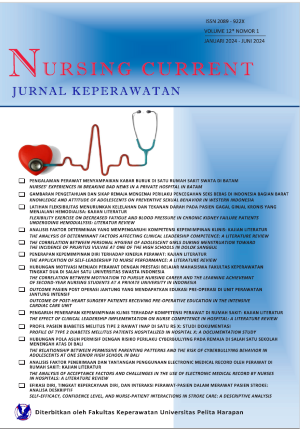Latihan Fleksibilitas terhadap Kelelahan dan Tekanan Darah pada Pasien Hemodialisis: Kajian Literatur [FLEXIBILITY EXERCISE ON DECREASED FATIGUE AND BLOOD PRESSURE IN CHRONIC KIDNEY FAILURE PATIENTS UNDERGOING HEMODIALYSIS: LITERATURE REVIEW]
DOI:
https://doi.org/10.19166/nc.v12i1.7868Keywords:
blood pressure, fatigue, flexibility excerciseAbstract
Chronic kidney failure is a noncommunicable disease that has a rising incidence rate annually. This disease poses a worldwide challenge due to the intricacy of its treatment. This condition can progress in stages 1-5. Patients in Stage 5 need to receive either hemodialysis or kidney transplants. Hemodialysis has the potential to impact the patient's level of weariness and blood pressure. The purpose of the literature review is to examine the impact of intradialytic flexibility training on fatigue and blood pressure. This activity is a non-pharmacological technique that enhances patient weariness and blood pressure. The research methodology employs literature evaluation utilizing three databases: Google Scholar, PubMed, and ResearchGate. The process of selecting publications followed the PRISMA protocol standards for identification, screening, and determining eligibility. As a result, a total of 11 papers were analyzed. The inclusion criteria for this study were as follows: respondents who were undergoing hemodialysis, a sample size of more than 20 respondents, a quantitative research design, full text articles available in both Indonesian and English, and a maximum year of article publication above 2014. Scientists gathered and examined published articles regarding the advantages of flexibility exercise on fatigue and blood pressure in individuals undergoing hemodialysis. Various studies in the literature review yield inconsistent results, nevertheless, a significant number of researchers demonstrate that therapies involving flexibility training can have an impact on fatigue and blood pressure. In conclusion, flexibility training enhances fatigue and blood pressure in hemodialysis patients by reducing peripheral vascular resistance, hence minimizing blood vessel rigidity and weariness resulting from insufficient physical activity during blood cleansing.
BAHASA INDONESIA Gagal ginjal kronis merupakan penyakit tidak menular yang angka kejadiannya meningkat setiap tahun. Penyakit ini merupakan masalah global karena kompleksnya pengobatan. Penyakit ini dapat memburuk dari stadium 1-5.Stadium 5 pasien harus menjalani hemodialisis atau transplantasi ginjal . Hemodialisis dapat mempengaruhi kelelahan dan tekanan darah pasien.Tujuan penelitian ini untuk menganalisa pengaruh latihan flexibility intradialyticterhadap kelelahan dan tekanan darah. Latihanini merupakan intervensi non farmakologis yang memperbaiki kelelahan dan tekanan darah pasien.Metode penelitian inimenggunakan literaturereview dengan menggunakan 3 database yaitu Google Scholar, Pubmed dan ResearchGate. Penyeleksian artikel menggunakan panduan protokol(PRISMA) dari identification, screening, eligibility dan menghasilkan 11 artikel yang dianalisa. Kriteria inklusi yaitu responden menjalani hemodialisis dengan jumlah sampel lebih dari 20 responden,desain penelitian kuantitatif, fulltext bahasa Indonesia maupun bahasa Inggris,maksimal tahun terbit artikel tahun 2014 -2024. Peneliti mengumpulkan dan menganalisis artikel yang telah terbit tentang manfaatlatihan flexibilityterhadap kelelahan dan tekanan darah pada pasien hemodialisis. Hasil dari literaturereview bervariasi namun banyak peneliti menunjukkan bahwa intervensi latihan flexibilitydapat berpengaruh terhadap kelelahan dan tekanan darah.Kesimpulannya latihan flexibilitymenurunkan kelelahan dan tekanan darah pasien hemodialisis akibat resistensi pembuluh darah perifer sehingga mencegah kekakuan pembuluh darah serta kelelahan karena kurangnya aktivitas fisik saat cuci darah.
References
Abdurrakhman, R. N., & Yuniar, Y. (2021a). Pengaruh flexibility exercise terhadap kekuatan otot pada pasien hemodialisis. Sekolah Tinggi Ilmu Kesehatan Cirebon 12(1). https://jurnal.stikescirebon.ac.id/index.php/kesehatan/article/view/218/0
Bikbov, B., Purcell, C. A., Levey, A. S., Smith, M., Abdoli, A., Abebe, M., Adebayo, O. M., Afarideh, M., Agarwal, S. K., Agudelo-Botero, M., Ahmadian, E., Al-Aly, Z., Alipour, V., Almasi-Hashiani, A., Al-Raddadi, R. M., Alvis-Guzman, N., Amini, S., Andrei, T., Andrei, C. L., ”¦ Vos, T. (2020). Global, regional, and national burden of chronic kidney disease, 1990-2017: A systematic analysis for the global burden of disease study 2017. The Lancet, 395(10225), 709-733. https://doi.org/10.1016/S0140-6736(20)30045-3
Djamaludin, D., Chrisanto, Y. E., & Wahyuni, M.S. (2020). Pengaruh latihan fisik terhadap penurunan fatigue pada pasien gagal ginjal kronis yang menjalani hemodialisa di rsud dr. h. abdul moeloek provinsi Lampung. Manuju: Malahayati Nursing Journal, 2(4). https://doi.org/10.33024/mnj.v2i4.1623
Dwiatmojo, N. F. (2020). Pengaruh intradialytic latihan dan terapi musik klasik terhadap tekanan darah intradialsis pada pasien ckd stage v yang menjalani hemodialisa. Prima: Jurnal Ilmiah Ilmu Kesehatan, 6(1). http://id.stikes-mataram.ac.id/e-journal/index.php/JPRI/article/view/159
Elhameed, S. H. A., & Fadila, D. E. S. (2019). Effect of exercise program on fatigue and depression among geriatric patients undergoing hemodialysis. International Journal of Advanced Nursing Studies, 8(2). https://doi.org/10.14419/ijans.v8i2.29316
Ehrman, J. K., Gordon, P. M., Visich, P. S., & Keteyian, S. J. (2013). Clinical Exercise Physiology. Journal of Sports Science and Medicine, . https://www.ncbi.nlm.nih.gov/pmc/articles/PMC3873670/
Gregg, L. P., Bossola, M., Ostrosky-Frid, M., & Hedayati, S. S. (2021). Fatigue in ckd epidemiology, pathophysiology, and treatment. Clinical Journal American Society of Nephrology, 16(9). https://doi.org/10.2215/CJN.19891220
Hirawa, N. (2023). Blood pressure management in hemodialysis patients. Hypertension Research, 46(7). https://doi.org/10.1038/s41440-023-01279-x
Jager, K. J, Kovesdy, C., Langham, R., Rosenberg, M., Jha, V., & Zoccali, C. (2019). A single number for advocacy and communication””worldwide more than 850 million individuals have kidney diseases. Kidney International, 96(5). https://doi.org/10.1016/j.kint.2019.07.012
Mahrova, A., & Svagrov, K. (2013). Exercise therapy - Additional tool for managing physical and psychological problems on hemodialysis. InTech. https://doi.org/10.5772/53058
Muliani, R., Muslim A. R , & Abidin, I. (2021). Intradialytic exercise: Flexibility terhadap skor fatigue pada pasien penyakit ginjal kronis yang menjalani hemodialisis. Journal of Medicine and Health, 3(2). https://doi.org/10.28932/jmh.v3i2.3147
Musniati, M., & Kusumawardani, D. (2019). Gejala fatigue pada pasien hemodialisa menggunakan skala fss. Jurnal Keperawatan Dan Kebidanan, 11(2). https://e-journal.lppmdianhusada.ac.id/index.php/jkk/article/view/99
Natashia, D., Irawati, D., & Hidayat, F. (2020). Fatigue dan kualitas hidup pada pasien gagal ginjal kronis dengan terapi hemodialisa. Jurnal Keperawatan Muhammadiyah, 5(2). https://doi.org/https://doi.org/10.30651/jkm.v5i2.6540
Noradina, N. (2018). Pengaruh Tindakan Hemodialisa Terhadap Perubahan Tekanan Darah Pada Klien Gagal Ginjal Kronik Di Rumah Sakit Imelda Medan Tahun 2018. Jurnal Ilmiah Keperawatan Imelda, 4(2). https://doi.org/10.52943/jikeperawatan.v4i2.295
Omega K. D., Putri K. P. A, Marcory, Y. S., Juhdeliena, J., & Wikliv, S. (2023). Perbedaan Tekanan Darah Intradialisis pada Pasien Gagal. Jurnal Keperawatan Cikini, 4(1). https://jurnal.akperrscikini.ac.id/index.php/JKC/article/view/107
Pu, J., Jiang, Z., Wu, W., Li, L., Zhang, L., Li, Y., Liu, Q., & Ou, S. (2019). Efficacy and safety of intradialytic exercise in haemodialysis patients: a systematic review and meta-analysis. BMJ Open, 9(1). https://doi.org/10.1136/bmjopen-2017-020633
Rhee, S. Y., Song, J. K., Hong, S. C., Choi, J. W., Jeon, H. J., Shin, D. H., Ji, E. H., Choi, E. H., Lee, J., Kim, A., Choi, S. W., & Oh, J. (2019). Intradialytic exercise improves physical function and reduces intradialytic hypotension and depression in haemodialysis patients. The Korean Journal of Internal Medicine, 34(3). https://doi.org/10.3904/kjim.2017.020
Sani, F. N., Kurniasari, D., & Am, A.I. (2022). Efektifitas intradialisis exercise terhadap perubahan tekanan darah pada pasien gagal ginjal kronik yang menjalani terapi hemodialisa. Jurnal Gawat Darurat, 4(1). https://journal2.stikeskendal.ac.id/index.php/jgd/article/view/1472
Silaen, H., Purba, J. R., & Hasibuan, M. T. D. (2023). Development of non-medical rehabilitation program to overcome weaknesses in hemodialized patients in medan city hospital. KESANS: Jurnal Internasional Kesehatan dan Sains, 2(1). https://doi.org/10.54543/kesans.v2i1.101
Soliman, H. M. M. (2015). Effect of intradialytic exercise on fatigue, electrolytes level and blood pressure in hemodialysis patients: A randomized controlled trial. Journal of Nursing Education and Practice, 5(11). https://doi.org/10.5430/jnep.v5n11p16
Stern, A. Sachdeva, S. Kapoor, R. Singh, J., & Sachdeva, S. (2014). High blood pressure in dialysis patients: cause, pathophysiology, influence on morbidity, mortality and management. Journal of Clinical of Diagnostic Research, 8(6). https://doi.org/10.7860/JCDR/2014/8253.4471
Tsirigotis, S., Polikandrioti, M., Alikari, V., Dousis, E., Koutelekos, I., Toulia, G., Pavlatou, N., Panoutsopoulos, G. I., Leftheriotis, D., & Gerogianni, G. (2022). Factors associated with fatigue in patients undergoing hemodialysis. Cureus, 14(3), e22994. https://doi.org/10.7759/cureus.22994
Downloads
Published
How to Cite
Issue
Section
License
Copyright (c) 2024 Marischa Wanti Esterlise Nainggolan, Ni Luh Widani

This work is licensed under a Creative Commons Attribution-ShareAlike 4.0 International License.
Authors who publish with this journal agree to the following terms:
1) Authors retain copyright and grant the journal right of first publication with the work simultaneously licensed under a Creative Commons Attribution License (CC-BY-SA 4.0) that allows others to share the work with an acknowledgement of the work's authorship and initial publication in this journal.
2) Authors are able to enter into separate, additional contractual arrangements for the non-exclusive distribution of the journal's published version of the work (e.g., post it to an institutional repository or publish it in a book), with an acknowledgement of its initial publication in this journal.
3) Authors are permitted and encouraged to post their work online (e.g., in institutional repositories or on their website). The final published PDF should be used and bibliographic details that credit the publication in this journal should be included.

This work is licensed under a Creative Commons Attribution-ShareAlike 4.0 International License.






